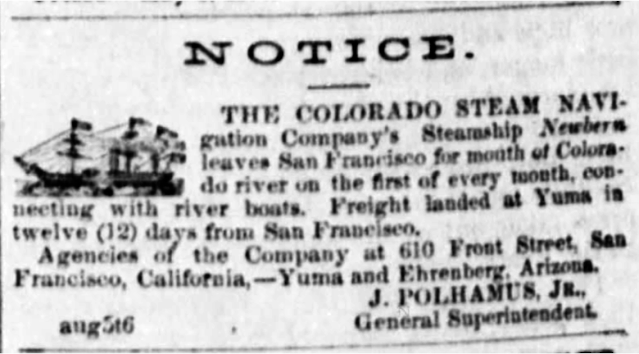On October 14, 2021, we decided to see what was happening 150 years ago in the Prescott newspaper, "The Weekly Arizona Miner." The are many interesting things in that old newspaper. We focused on a small Page 2 "Notice" regarding steamship passage from San Francisco to the Mouth of The Colorado River. That was a distance of 2,100 miles which cost a First Class passenger about $2,000 in today's inflated dollars. Narratives and some links are under each screen clip. Our primary source is cited at the end of this post.
Source: https://www.newspapers.com/clip/87077069/ss-newbern-1817/
This is "probably" an illustration of the Steamship Montana judging from the location of the smoke stack. In those days, ocean going, coal-fired steamships were propeller-driven. Here is one narrative excerpt from "Steamships of The Colorado River": "The greatest growth of the Colorado Steam Navigation Company came in 1871 when they purchased an ocean-going steamer, the Newbern, and opened a direct steamer route from San Francisco to connect with the riverboats at Port Isabel. The Newbem, built in Brooklyn in 1852, was a 943-ton, 375-horsepower, propeller-driven vessel, 198 feet long with a 29-foot beam. Under Captain A. N. McDonough she began regular monthly trips to the river on 2 July 1871. She made the 2,100-mile voyage in just twelve days, nearly cutting in half the usual sailing time and greatly expediting passenger and freight service. Passenger fare from San Francisco to Yuma was $90 for first cabin and $40 for steerage. In the boom years of the 1870s the Colorado steamers were carrying more than a hundred passengers a month, and the accommodations were good enough so that a few adventuresome souls even took the trip purely for pleasure."
(Source cited at end of post.)
Note the size and location of the smoke stack on the Newbern compared to the previous illustration. This photo came from an article about wreck diving and some details differ from the above narrative:
"The Newbern was constructed by the firm C & R Poillon in Brooklyn. N.Y. in 1862. The government bought her during the Civil War and christened her the United States, but later changed her name to the Newberne. She was 198 feet long, had a 29 foot beam, measured 943 tons gross and was coal powered by a 250 horsepower steam engine. After her service during the Civil War, she sailed to the West Coast via Cape Horn in 1867 and was sold to Hartehan & Wilson. The new owners changed her name by dropping last "E" and gave command of the ship to Capt. Eugene Freeman. In 1869, Capt. Metzger sailed the Newbern from San Francisco to Mexican ports in the Sea of Cortez. In 1871, the Newbern was sold to Capt. George A. Johnson of the Colorado Steam Navigation Co. who continued to turn high profits from the trade with Arizona and Nevada, now accessible via Port Isabel at the foot of the Colorado River."
Source: http://www.cawreckdivers.org/Wrecks/Newbern.htm
This is an illustration of the man whose name is listed in the 1871 Notice, J. Polhamus, Jr. He is arguably the most famous individual associated the steamboat commerce on The Colorado River. (Source cited at end of post.)
http://www.ansac.az.gov/UserFiles/PDF/08182014/X028_FMIBurtellLingenfelterSteamboats/FMI%20Lingenfelter%20Steamboats/Steamboats%20on%20the%20Colorado%20River%201852-1916.pdf
























